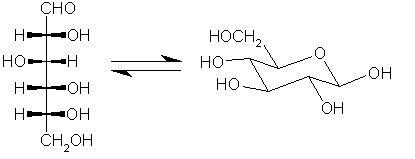 Cellulose is a polymer
made up of many glucose units. Free glucose is in
equilibrium between linear and cyclic forms.
Cellulose is a polymer
made up of many glucose units. Free glucose is in
equilibrium between linear and cyclic forms.
| MadSci Network: Chemistry |
 Cellulose is a polymer
made up of many glucose units. Free glucose is in
equilibrium between linear and cyclic forms.
Cellulose is a polymer
made up of many glucose units. Free glucose is in
equilibrium between linear and cyclic forms.
In cellulose these monomers are linked in a beta-1,4 fashion to give a long linear molecule that can easily hydrogen bond with its neighbours to form a crystalline material.
Although a cellulose molecule may contain many thousands of glucose units,
the single groups on the ends of the polymer are chemically distinct - the
end that can open is called the reducing end and the other end is
called the non-reducing end.

The periodate ion can cleave any vicinal diol - that is, break any
carbon-carbon bond where each of the carbons has an alcohol substituent.
Treatment of a 1,4-polysaccharide with periodic acid will therefore create
distinctive products from the only two substituents that can be completely
cleaved, the reducing and non-reducing ends. One molecule of formic acid
will be generated at each non-reducing end, as periodate attacks the bonds
shown below:

To determine the average degree of polymerisation of your cellulose, therefore, convert your weight of cellulose into moles of glucose and your weight of formic acid into moles. The ratio of these two numbers will give you the number of molecules of glucose per non-reducing ends - that is, the degree of polymerisation of your cellulose.
[A useful reference is the article on chemical characterisation of polysaccharides by G. Aspinall in "The Polysaccharides", Academic Press 1982, volume 1 pp.81-89]
Try the links in the MadSci Library for more information on Chemistry.